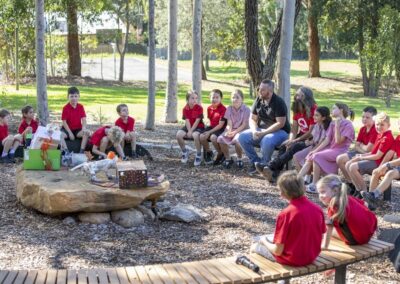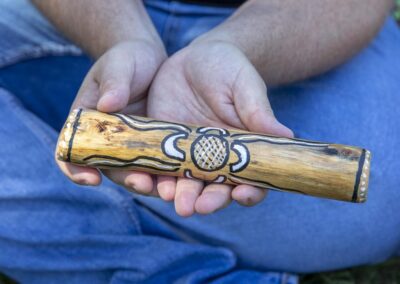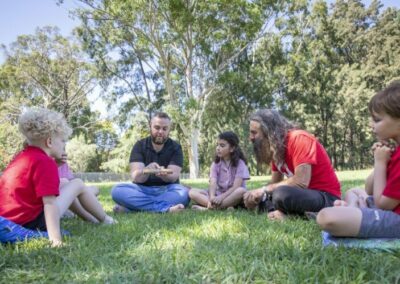LEARNING ACTIVITY
STORY
Jarrah was very excited. Aunty Vi had spoken to his class about the importance of yarning circles and how to create one in his school. Aunty Vi mentioned that the yarning circle could be used to share knowledge and Culture, and so his school invited her son, Uncle Paul, to share a dreamtime/teaching story.
Jarrah and his classmates walked towards the old Kurrajong in their schoolyard. Uncle Paul brought out mats for them all to sit on in a circle. As Uncle Paul spoke and shared his story, Jarrah gazed out at the large Kurrajong and listened to the small native bees buzzing around its white flowers.
After Uncle Paul finished his story, he pointed out the seed pods of the Kurrajong and spoke about how they are important culturally for food and dance.
Uncle Paul then asked if anyone would like to speak and noted that they would each have their chance to speak while the others listen. Jarrah took the opportunity to say a few words.
Jarrah:“I would like to thank you, Uncle Paul, for coming to our school and sharing your story and knowledge about the Kurrajong in our yarning circle!”

This activity is the sixth activity in an 8-part activity sequence that has been developed to help you design, build and use a yarning circle in your space.
This activity provides a plan for how to use your yarning circle.
The order of these learning activities are: background, site selection, involving First Nations people, building the yarning circle, connecting to Landcare, using the yarning circle, yarning circle activities,yarning and wellbeing.
For children to:
- understand that different cultures may have different styles of communication
- appreciate that local native plants and animals hold important cultural elements for First Nations people
- reflect on and share the knowledge they acquire.
This activity can be undertaken at any time of the year.
Introduction
You did it! Your yarning circle is now complete. It looks extremely inviting and has become a central point of attraction within your school. The question now is, how and when do you use it?
The main thing is that it does not just become a token gesture and space that isn’t well utilised in the school. A yarning circle can be used as a teaching and learning space for your everyday classes, when sharing and discussion is an important focus of the lesson.
When to use a yarning circle:
A yarning circle can be used whenever you need to have a chat, share or mediate. In a school setting, it could be used when:
You may wish to hold smaller intimate circles on regular occasions (for example, once a week) and then plan to hold larger ones where an Elder or First Nations community member/s are invited into the space, if/when possible.
Talking sticks:
This activity also introduces the concept of a talking stick. The stick symbolises your turn to have your say; when others should respectively listen to you before having their turn to speak with the stick. The yarning circle can continue until everyone has had their turn to speak, be listened to and voice any concerns or opportunities they wish to pursue. This will embed an important practice and safe space for all students so they feel comfortable sharing.
Checklist
Instructions

Step 1
Head outside:
Open the yarning circle.
If possible, invite a local Elder or respected community member to help lead and run the yarning circle. We understand this won’t always be possible.
Begin this activity with an Acknowledgement of Country. By acknowledging the Land, you are also making a promise that you will recognise the cultural practices of First Nations people.
Invite students to sit in the space to have a discussion.
Reflect on your earlier learning in the first activity in this sequence ‘Creating a yarning circle – background’.

Step 2
Communication in a yarning circle:
Explain to your students that in the circle you are all facing each other and so are visible to one another.
- This is important for First Nations people as body language is a culturally important part of communication.
- It also sets up a level or equal communicative line as opposed to one person talking or leading conversation in front of a group.
- The circular shape promotes equality, dialogue and mutual respect.

Step 3
Taking turns with talking sticks:
Explain that taking turns is an important part of a yarning circle so that everyone is heard.
A useful tool to ensure that everyone has a turn in a yarning circle is a talking stick.
A talking stick is often designed with cultural markings. (A member of the circle can request the stick from an Elder or community member when you are planning for the opening of your yarning circle and beginning the proceedings and conversation.)
Ask the students whether they think using a talking stick would be a good addition to your yarning circle.
Model how it could be used.
(If an Elder or local First Nations community member is present, ask them to explain the significance of the type of material and any markings that can or have been applied to the talking stick.)

Step 4
Investigating talking stick materials:
You or your students may suggest that they make their own talking stick. This could be appropriate, with guidance from your local Elder or First Nations community member/s.
Explain that First Nations cultures have beliefs about plants, animals and the landscape.
Explain that some materials, such as a stick from a particular Eucalypt, may not be culturally appropriate to use in your area.
Ask students for ideas about the types of materials they could use to make a talking stick and how they could investigate if these materials would be culturally appropriate to use? You could also discuss alternatives to a talking stick (some schools even use a microphone).
Discuss with students how they can share the information and knowledge they have learned with others in the school and community.
Make a plan about how you will share your knowledge to the school community.
If you already have guidance from an Elder about making a talking stick for your yarning circle, ask your students to draft an information text about the stick, the materials that have been used to make it and its significance.
Extension Activity
As a class, make a list of the local:
- Indigenous plants
- Indigenous animals
- Landscape features.
It is likely that many of these will have cultural significance for First Nations people. Discuss how you might be able to find out more information about these.
Curriculum and Framework Links
SCIENCE
Year 5: ACSHE083
Year 7: ACSHE120
Year 8: ACSHE135
HUMANITIES AND SOCIAL SCIENCES
Year 2: ACHASSI042
Year 3: ACHASSI052, ACHASSI059, ACHASSI060
Year 4: ACHASSI080, ACHASSK088, ACHASSK090
Year 5: ACHASSI102, ACHASSK120
Year 6: ACHASSI122, ACHASSI130
DESIGN AND TECHNOLOGIES
Year 2: ACTDEK003
Year 3 & 4: ACTDEP017
Year 5 & 6: ACTDEP019
Year 7 & 8: ACTDEK032
HEALTH AND PHYSICAL EDUCATION
Year 2: ACPPS018, ACPPS022, ACPPS023
Year 3 & 4: ACPPS036, ACPPS040, ACPPS041
Year 5 & 6: ACPPS054, ACPPS059
Year 7 & 8: ACPPS073, ACPPS078
ABORIGINAL AND TORRES STRAIT ISLANDER HISTORIES AND CULTURES
ETHICAL UNDERSTANDING
Exploring values, rights and responsibilities.
PERSONAL AND SOCIAL CAPABILITY
CURRICULUM CONNECTIONS
CROSS CURRICULUM PRIORITY
MY TIME, OUR PLACE: FRAMEWORK FOR SCHOOL AGE CARE
Reference List
ONLINE RESOURCES
Yarning is an important part of First Nations culture and supports building respectful relationships. Learn more about the significance of yarning here.
PRINTABLE RESOURCES
Download ‘Indigenous plant use: A booklet on the medicinal, nutritional and technological use of indigenous plants’ by Zena Cumpston, here.
WATCH
Featuring proud Wemba Wemba, Gunditjmara, Ngadjonji and Taungurung artist Emma Bamblett, watch this video for tips on how to make yarning sticks at home.
Find out the impact a microphone used as a talking stick has had for students in this short video with Adam Shipp and school teacher Mrs Clare here.
NETWORK
We recommend reaching out to the Local Traditional owners and First Nations peoples community groups who can assist in knowledge sharing and understanding local land, language, stories and culture.
To reach out or find contacts in your local First Nations community you could speak to parents of First Nations students, to an Indigenous Learning Officer (ILO) at your school or to a local Land council.
We have some suggested organisations to approach listed on our Junior Landcare Community page.
We value your feedback
When you have finished this learning activity, please tell us what you think with our survey.
Your feedback will help Landcare Australia improve the activities in the Junior Landcare Learning Centre.
Why not try one of our other Junior Landcare learning activities?
Creating an Indigenous plant-use garden: plant list
First Nations Perspectives
Creating an Indigenous plant-use garden: resources from the bush
First Nations Perspectives
Love Letters to the Land
Biodiversity|First Nations Perspectives|Food Production|Waste Management
Creating a yarning circle: involving First Nations people
First Nations Perspectives